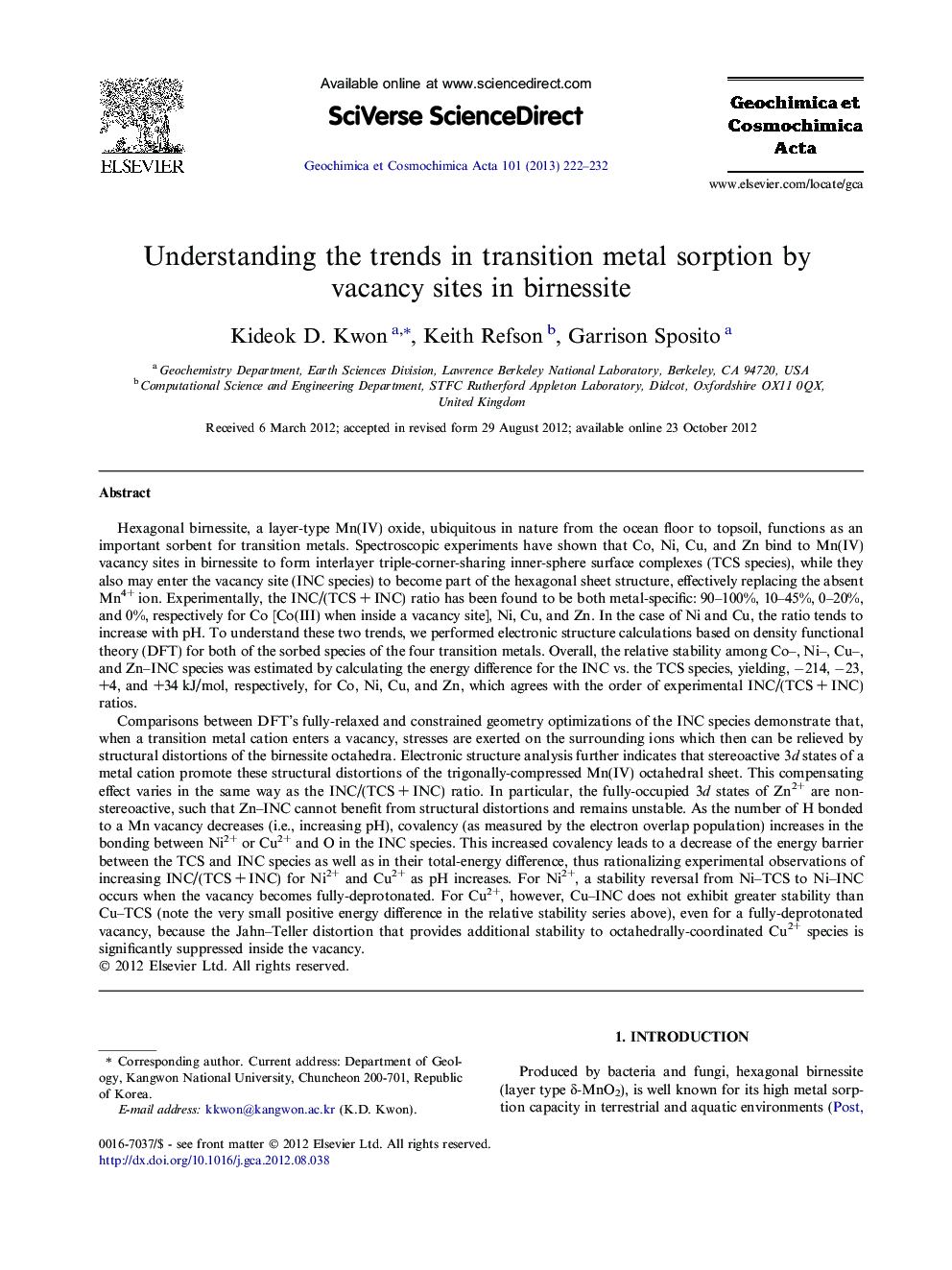| کد مقاله | کد نشریه | سال انتشار | مقاله انگلیسی | نسخه تمام متن |
|---|---|---|---|---|
| 4702532 | 1638056 | 2013 | 11 صفحه PDF | دانلود رایگان |
Hexagonal birnessite, a layer-type Mn(IV) oxide, ubiquitous in nature from the ocean floor to topsoil, functions as an important sorbent for transition metals. Spectroscopic experiments have shown that Co, Ni, Cu, and Zn bind to Mn(IV) vacancy sites in birnessite to form interlayer triple-corner-sharing inner-sphere surface complexes (TCS species), while they also may enter the vacancy site (INC species) to become part of the hexagonal sheet structure, effectively replacing the absent Mn4+ ion. Experimentally, the INC/(TCS + INC) ratio has been found to be both metal-specific: 90–100%, 10–45%, 0–20%, and 0%, respectively for Co [Co(III) when inside a vacancy site], Ni, Cu, and Zn. In the case of Ni and Cu, the ratio tends to increase with pH. To understand these two trends, we performed electronic structure calculations based on density functional theory (DFT) for both of the sorbed species of the four transition metals. Overall, the relative stability among Co–, Ni–, Cu–, and Zn–INC species was estimated by calculating the energy difference for the INC vs. the TCS species, yielding, −214, −23, +4, and +34 kJ/mol, respectively, for Co, Ni, Cu, and Zn, which agrees with the order of experimental INC/(TCS + INC) ratios.Comparisons between DFT’s fully-relaxed and constrained geometry optimizations of the INC species demonstrate that, when a transition metal cation enters a vacancy, stresses are exerted on the surrounding ions which then can be relieved by structural distortions of the birnessite octahedra. Electronic structure analysis further indicates that stereoactive 3d states of a metal cation promote these structural distortions of the trigonally-compressed Mn(IV) octahedral sheet. This compensating effect varies in the same way as the INC/(TCS + INC) ratio. In particular, the fully-occupied 3d states of Zn2+ are non-stereoactive, such that Zn–INC cannot benefit from structural distortions and remains unstable. As the number of H bonded to a Mn vacancy decreases (i.e., increasing pH), covalency (as measured by the electron overlap population) increases in the bonding between Ni2+ or Cu2+ and O in the INC species. This increased covalency leads to a decrease of the energy barrier between the TCS and INC species as well as in their total-energy difference, thus rationalizing experimental observations of increasing INC/(TCS + INC) for Ni2+ and Cu2+ as pH increases. For Ni2+, a stability reversal from Ni–TCS to Ni–INC occurs when the vacancy becomes fully-deprotonated. For Cu2+, however, Cu–INC does not exhibit greater stability than Cu–TCS (note the very small positive energy difference in the relative stability series above), even for a fully-deprotonated vacancy, because the Jahn–Teller distortion that provides additional stability to octahedrally-coordinated Cu2+ species is significantly suppressed inside the vacancy.
Journal: Geochimica et Cosmochimica Acta - Volume 101, 15 January 2013, Pages 222–232
